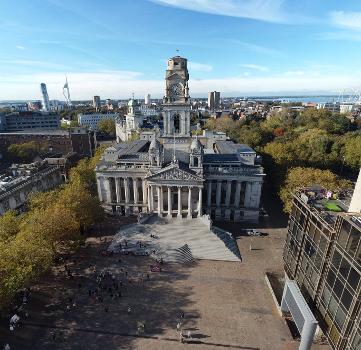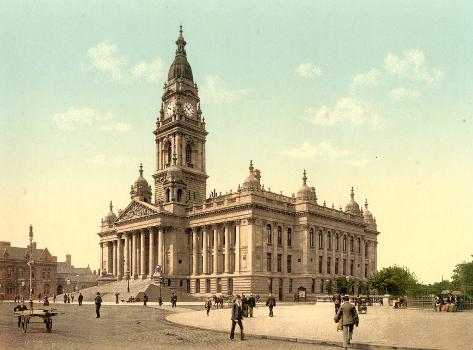General Information
| Other name(s): | Portsmouth Town Hall |
|---|---|
| Completion: | 1890 |
| Status: | in use |
Project Type
| Architectural style: |
Neoclassical |
|---|---|
| Function / usage: |
original use: City or town hall current use: Concert hall current use: Congress center |
Awards and Distinctions
Location
| Location: |
Portsmouth, Hampshire, South East England, England, United Kingdom |
|---|---|
| Coordinates: | 50° 47' 51.54" N 1° 5' 34.38" W |
Technical Information
There currently is no technical data available.
Excerpt from Wikipedia
Portsmouth Guildhall is a multi-use venue in the centre of Portsmouth, UK, located on a pedestrian square close to the Portsmouth and Southsea railway station. Constructed in 1890 and originally used by the local council, the building was known as Portsmouth Town Hall until 1926. It was heavily damaged by bombing during the Second World War and largely rebuilt during the 1950s. Today it operates as a concert, wedding and conference venue.
History
The building was designed in the neo-classical style by architect William Hill, who had previously designed the visually similar Bolton Town Hall. Local architect Charles Bevis, in partnership with Hill, directed the construction. Hill died before the building was completed and Bevis added to the design.
When completed in 1890, the building became the civic town hall. On 21 April 1926 Portsmouth was raised to the status of a city and the town hall was simultaneously renamed the Guildhall.
On 10 January 1941, during the Second World War, it was hit by enemy incendiary bombs. The resultant fire gutted the building, completely destroying the interior and roof. Just the outer walls and tower remained standing, and those were fire-damaged. The Guildhall was rebuilt after the war at a cost of £1.5 million, using war compensation funds. The interior was altered from the original and the external style is missing much of its original detail, especially the dome above the clock and the finials atop the balustrades around the roof. Elizabeth II re-opened the building in a ceremony on 8 June 1959.
Bells
There are five bells in its bell tower, collectively nicknamed The Pompey Chimes, as they inspired the football chant of the same name. The largest of the five bells, Victoria is named after Queen Victoria and is inscribed with her name, and chimes on the hour. The four quarter bells chime at 15, 30 and 45 minutes past the hour and play the Westminster Quarters, just before Victoria tolls on the hour.
The Pompey Chimes fell silent in 2003 when the bell tower was found to be in need of restoration from the corrosive nature of sea salt in the Portsmouth air. The work was carried out by Smith of Derby Group, the restoration project finishing in time for Queen Elizabeth's visit to Portsmouth in 2009 to mark the 65th anniversary of the D-Day landings.
The four quarter bells were to have been officially named Nelson, Victory, John Pounds and Harry Redknapp in a 2008 public poll by Portsmouth City Council in 2008. The official naming was stalled due to the high popularity of internet votes for Harry Redknapp's name from unregistered anonymous voters. Redknapp, the former Portsmouth Football Club manager had suddenly departed the club for Tottenham Hotspur F.C. shortly before bell name voting commenced, which had left a wide range of emotions among many Portsmouth Football Club fans and city residents. Foul play, possibly from rival football supporters was suspected by Portsmouth City Council, who had organised the vote, and the four quarter bells have remained unnamed.
Current use
The Guildhall now operates as a concert, wedding and conference venue. It has been managed by the Portsmouth Cultural Trust,a registered charity, since 2011.
The main hall has a standing capacity of up to 2,500 for concerts, whilst other rooms can accommodate up to 500 people for weddings or banquets. Facilities include a café, art galleries, meeting rooms and a business lounge.
Text imported from Wikipedia article "Portsmouth Guildhall" and modified on July 23, 2019 according to the CC-BY-SA 4.0 International license.
Participants
- William Hill (architect)
- Ernest Berry Webber (architect)
Relevant Web Sites
- About this
data sheet - Structure-ID
20035351 - Published on:
09/03/2008 - Last updated on:
16/09/2022







